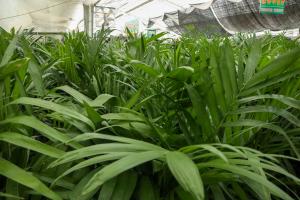Introduction
Plants are complex organisms that rely on water and nutrients to survive. The way that water moves through a plant is a fascinating process, and it is essential to the growth and development of the plant. In this article, we will explore the question, "How does water move up a plant stem?" and look at the various processes involved.
Transpiration
One of the primary mechanisms responsible for the movement of water up a plant stem is transpiration. Transpiration is the process in which water is lost from the surface of a plant's leaves, either through evaporation or diffusion. As water is lost from the leaves, it creates a pull, or tension, that extends down through the plant's stem and into the roots. This pull is driven by a combination of factors, including the humidity of the surrounding air, temperature, and wind speed.
Cohesion-Tension Theory
The cohesion-tension theory is a widely accepted explanation for the way that water moves through a plant stem. According to this theory, the movement of water up a plant is driven by two forces: cohesion and tension. Cohesion is the attraction between water molecules, while tension is the pull on water molecules created by the transpiration process. When water is pulled up through the plant's stem, it forms a continuous column due to the cohesive forces between water molecules. This column of water is under tension, which helps to pull more water up through the plant.
Root Pressure
In addition to transpiration and the cohesion-tension theory, root pressure also plays a role in the movement of water up a plant stem. Root pressure is the force that drives water and nutrients upwards from the roots of a plant. This pressure is created by the accumulation of mineral ions and other solutes in the root cells, which causes water to move into the roots from the surrounding soil via osmosis. As more water enters the roots, it increases the pressure, which helps to push water up through the plant's stem.
Xylem and Phloem
The xylem and phloem are two types of vascular tissues that are responsible for the transportation of water and other essential nutrients throughout a plant's body. The xylem is the tissue responsible for moving water and minerals from the roots to the rest of the plant. It is a series of interconnected tubes that run vertically through the plant's stem. The phloem, on the other hand, is responsible for the movement of sugars and other nutrients from the leaves to other parts of the plant. It is another set of tubes that run parallel to the xylem. Together, these two tissues work in tandem to ensure that the plant has the essential nutrients it needs to thrive.
Conclusion
The movement of water up a plant stem is a complex process that involves various mechanisms working together. Transpiration, the cohesion-tension theory, root pressure, and the xylem and phloem all play a critical role in ensuring that water and essential nutrients are distributed throughout the plant. Understanding how water moves through a plant is important, as it allows us to better appreciate the complexity of these amazing organisms and the role they play in our world.

 how many times do yo...
how many times do yo... how many planted tre...
how many planted tre... how many pine trees ...
how many pine trees ... how many pecan trees...
how many pecan trees... how many plants comp...
how many plants comp... how many plants can ...
how many plants can ... how many plants and ...
how many plants and ... how many pepper plan...
how many pepper plan...
































